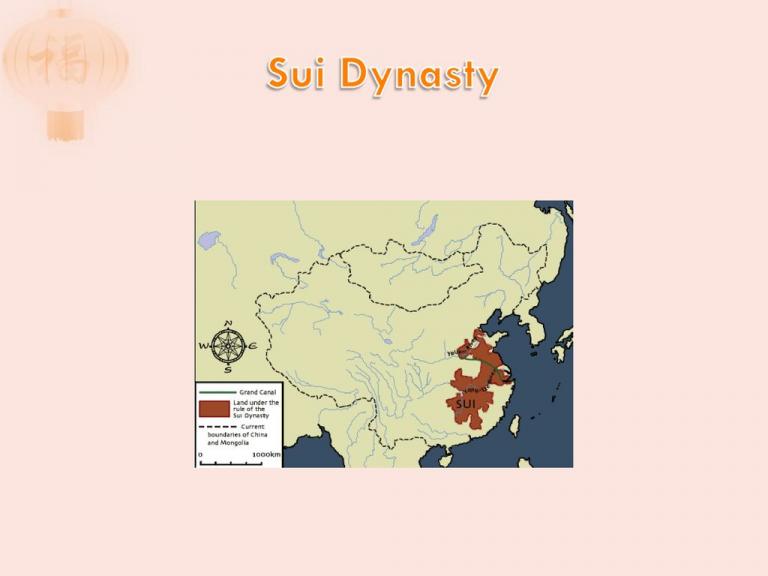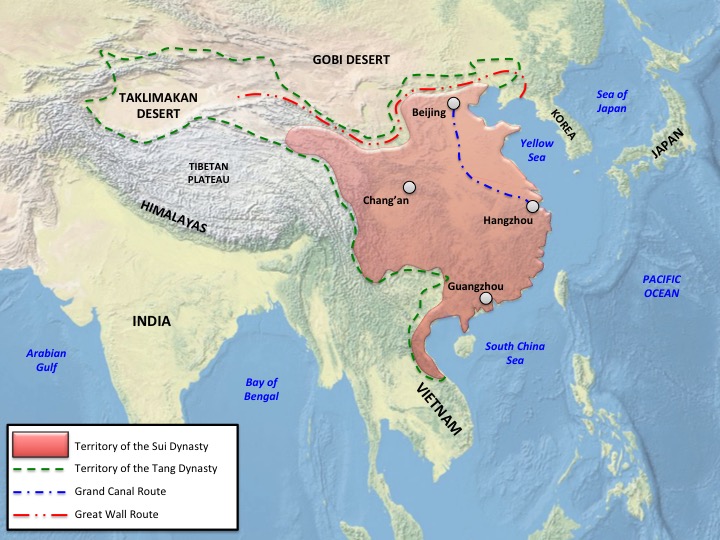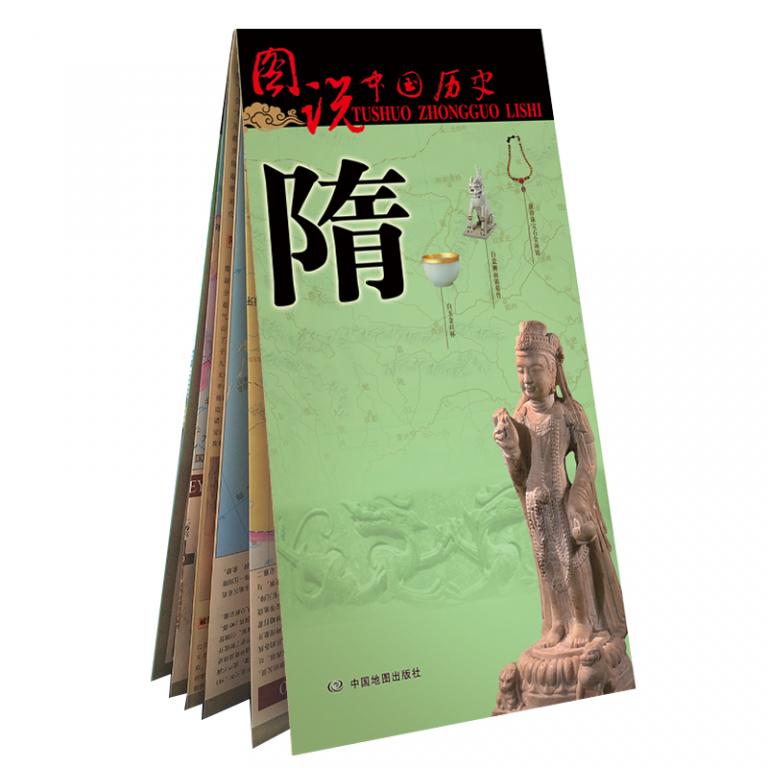Map of the canal the Sui Dynasty
5 min readThe first was during the 5th century BC,in the latter part of the Spring and Autumn Period.At the time,the ruler of the state of Wu,south of the Yangtze River,was attempting to usurp the position of the warlord of the Central Plains.He needed a logistical supply route for his armies.He mobilized labor to construct the canal from what is now Yangzhou towards the northeast,passing through Sheyang Lake to Huai-an,and entering the Huai River.Water from the Yangtze River was led into the Huai River,and this stretch of 170 kilometers became the earliest section of the Canal.

The second stage was in the early 7th century when the Sui Dynasty(581-618)reunified the country.This became the primary period of canal construction.The second Emperor of the Sui decided to move the capital to Luoyang in order to enable control of the vast area south of the Yangtze River.To allow the rich products of the Yangtze River delta area to be transported to Luoyang,he ordered the extension of the previous canal.It is said that he also wanted to create an aesthetic enjoyment for people of the rich and populous area around Yangzhou as they boated from Luoyang down to Yangzhou.In the year 605,he mandated the cutting of a canal of over 1,000 kilometers extending from Luoyang to Qingjiang in Jiangsu Province,a place now known as Huaiyin.Water was diverted from the Yellow River,curved its way toward the southeast,then merged the waters of the Luo River,the Yellow River and the Huai.This was known as the Tongji Canal.In 608,he ordered that the canal be extended by another 1,000 kilometers towards the north,to a place to the southwest of current Beijing.This section was then known as the Yongji Canal.In 610,he again ordered that a 400 kilometers’section be cut from Zhenjiang in Jiangsu province to Hangzhou in Zhejiang province.This section was then called the Jiangnan Canal(”south of the river”canal).At the time,Hangzhou was the major port city doing foreign trade in China.Han’gou Canal was also reconstructed.A canal that extended 1,700 kilometers and linked Hangzhou and Luoyang was then ready,which could allow the passage of boats transporting goods.

The Sui Dynasty had reunified China after the long period of fragmented rule known as the Three Kingdoms, Two Jins, and Northern and Southern Dynasties. Reunification provided opportunities for economic and social development and the early Sui period did indeed see tremendous advances. The book One Hundred People who have changed the Fate of Mankind includes Sui Emperor Wendi(name: Yang Jian) as one of the world’s great men of history. Yang Jian’s successor, Sui Yangdi(name: Yang Guang), quickly reversed this situation however with annual military campaigns and a despotic rule that disregarded the people’s welfare. He not only lost territory, he also lost his head. Nonetheless, the canal that he contributed to repairing and maintaining left a rich legacy for later generations. It was important in the unification of the country, in economic development, in the growth of cities along the way, in ease of transporting goods and in enriching cultural intercourse. As a result, the Grand Canal becamea vital artery in China between north and south.
The third stage in building the canal came after the Mongol-ruled Yuan Dynasty(1271-1368) established their capital in Beijing in the 13th century. In order to link north and south directly without having to go around by way of Luoyang, the Yuan Dynasty invested ten years in digging out sections between the Luozhou River and the Huitong River. This then linked up the natural river and lake system between Tianjin and Jiangsu’s Qingjiang. To the south of Qingjiang the canal linked up with the previous constructions all the way to Hangzhou. Theoriginal section of canal between Beijing and Tianjin had been abandoned, so a new”Tonghui Canal”was rebuilt. After this, the new Jing-Hang Canal was shorter than the original by more than 900 kilometers.
In 2006, China began the application for World Heritage for the Jing-Hang Canal. In announcing this project, the government pointed out,”The Jing-Hang Canal is a manifestation of our country’s superiority over the world in water engineering and transport and it has been bequeathed to us as a rich legacy. It nurtured the development of many famous cities, it provided a foundation for cultural richness, it precipitated all kinds of information exchange regarding our country’s political, economic, cultural, and social conditions. The Grand Canal, together with the Great Wall, are the symbol of the high status of Chinese culture itself. Pro-tecting the canal has tremendous significance in the transmission of humankind’s civilization and the harmonious integration of society.”

Although endowed with tremendous capabilities, Sui Emperor Yangdi(569-618) was eventually unable to restrain his own crazy desires, and he paid a high price for his rapacious rule. The second son of Sui Wendi, he had seized the throne in 604 and then governed as one of China’s most ruthless rulers. In deciding to move the capital to Luoyang, he conscripted a labor force of two million men to build the city. To the west of Luoyang he built the Western Garden-a striking site with its towers and pavilions set in an area of more than 200 mu. He used the garden for leisure and entertainment, viewing sights with several thousand palace women on horseback, enjoying banquets, leading a dissolute life. In the process of constructing the Grand Canal, he is said to have used 1 50 million workers, many of whom perished of exhaustion. When he found one stretch to be too shallow, in a fury he ordered that 50,000 officials and workers be buried alive. From August 605, he passed through the canal to Jiangdu three times on inspection tours. He rode in a great dragon boat,200 feet long,45 wide, and fourstories high. Concubines, officials, eunuchs and monks accompanied him on several thousandother boats: the entourage is said to have extended some 200 1i.80,000 men were employed just in hauling the boats along. Protective armies on horseback patrolled the banks of the canal on either side. The populace in the vicinity were forced to contribute food and drink for this traveling city. Yang Guang initiated war three times against Korea. The carpenters building boats worked day and night to make ready, and it is said that three or four out of every ten died.
The navy of the Sui and the army attacked Korea on two fronts, each of the three attempts was repulsed and ended in defeat. The rich reserves that had been built up during the period of Sui Wendi were exhausted. The fields began to go bare,a scorched landscape covered the land, farmers had nothing to eat but bark and leaves. In 611,a peasants revolt erupted. Yang Guang continued, however, to lead his dissolute life. In 618, the Right-flank General Yuwen Huaji stole into the palace and strangled the Emperor, after which the Sui Dynasty was destroyed. In total, it had existed for 38 years and been ruled by two men.
Randeng Pagoda in Tongzhou,Beijing,built in the last years of Northern Zhou,before the excavation of the Sui canal.It stands at the north bank of the canal and witnessed more than 1,300 years of water transportation on the canal.








